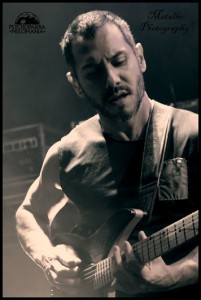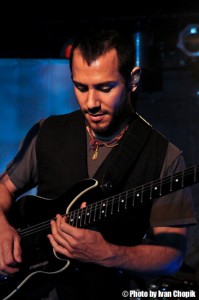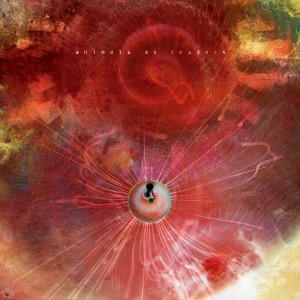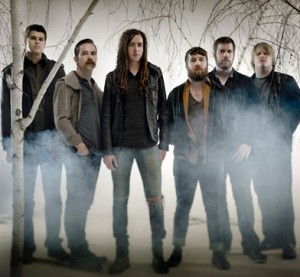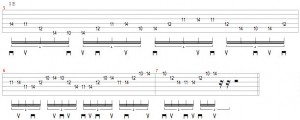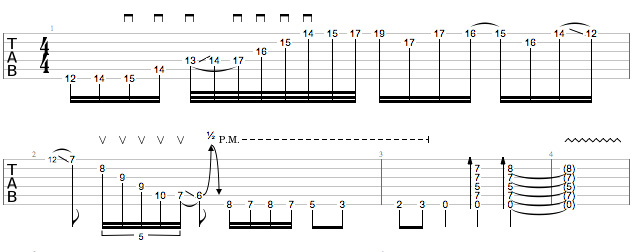 In the first part of our interview, Paul Masvidal took us inside the composition and recording process for Kindly Bent to Free Us. Read on for some insight into the tools of the trade he employed to make the album and why you should be first in line to pick up his new .strandberg* Masvidalien signature guitar.
In the first part of our interview, Paul Masvidal took us inside the composition and recording process for Kindly Bent to Free Us. Read on for some insight into the tools of the trade he employed to make the album and why you should be first in line to pick up his new .strandberg* Masvidalien signature guitar.
Part I | Part III | Part IV
GEAR
LD: I know you were using the [Fractal Audio] Axe-Fx Ultra on Carbon-Based Anatomy. What is your amp and guitar setup like these days, both in the studio and live?
PM: I still don’t have the Axe-Fx II and I was really curious about it. I called my friend Tosin [Abasi of Animals As Leaders] and said ‘I want to try one of these new ones out,’ so he let me borrow his rig. It was some trippy cabinet setup, a hybrid of his and Javier [Reyes of Animals As Leaders]’s rig. I went in and spent what seemed like forever creating some of my own patches. The menus are just infinite in that thing! It’s a bit overwhelming, actually. I just created the Dream Dirty patch and the Dream Clean patch. The Clean patch was just a bare bones jazz tone and the Dirty patch was the Friedman, a modified Marshall kind of vibe – just a very precise thing I was looking for.
That was it for the studio. I haven’t really thought about where I’ll get something close enough that will work for the live context. I’ll probably use the Axe-Fx, although I’ve been interested in the Kemper Profiling Amp. I’m curious about other amps and other setups and I’m just not really fixed on one yet. I think the advantage of the Axe-Fx is that you have all those effects at your disposal. You can put a whole mini rig into a two-space rack unit. For live touring that’s really helpful. I just did a tour with a thirteen-space rack and it’s just heavy and bulky and complicated. It always helps to narrow that down.
For guitars I used my Strandbergs. At the time I had the prototype for the Masvidalien, the signature model that I have coming out. Also I used another Varberg, which has different woods and DiMarzio pickups, instead of EMGs, and it sounds amazing. I combo-ed between those two on the record.
LD: Speaking of your .strandberg* Masvidalien signature guitar, what makes it yours?
PM: We broke it down in terms of how we wanted it. We obviously had the Varberg model as a template. I did a little bit of research in terms of wood and what I was looking for. The top is a rock maple and the back is African mahogany. There’s a certain tonal color that I would explain to Ola [Strandberg] I was looking for and he would suggest things. It has that [Endur] neck that he patented, where your thumb remains in almost classical position throughout the neck. I immediately connected with that. It just felt natural from the get-go. On an aesthetic level, it has the crop circle tattoo thing of mine that extends to the fret markers and inlays. Still, I’ve gone through so many phases of being very specific about my instrument, and then realizing that you can just hand me anything and I’m going to make music with it.
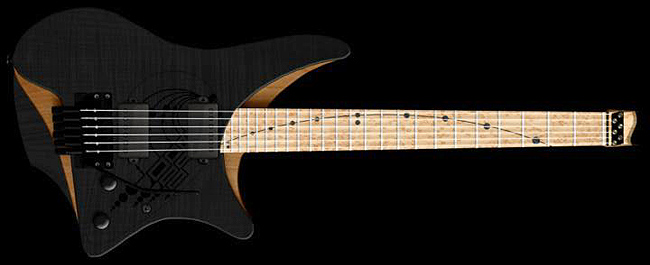
.strandberg* Masvidalien
I think with this thing, what really connected with me on multiple levels was that here’s the next generation of a headless guitar! I’ve been playing Steinbergers since basically the late ‘80s, early ‘90s, and here was this guy that’s a real boutique luthier who takes so much pride in his work. He’s really doing it! He’s creating these beautiful instruments that are still headless and making them cool for a whole new generation of people. That’s really what spoke to me. To this day still people ask me ‘How do you tune it, man?’ I’m realizing that the headstock became such a fixture in people’s collective psyche.
I just feel like it’s extremely versatile in the same way that the Steinbergers were. You can get so many different tones and colors out of it. Part of it is these different woods and it’s also hollowed out, so it has this like massive expansive vibe like you hear in an acoustic guitar. It’s really loud unplugged, almost like a semi-hollow body, but not – it’s still this little compact electric guitar. It merges a lot of old school aesthetics mixed with complete futurism. It’s really the perfect combination of elements for me in what I want in a guitar.
It’s so well made, that anyone who’s a fan of guitars in general should buy it, even just as a collector’s piece, because they’re only going to go up in value. These guitars, five to ten years, you watch, they’re just going to be worth a shit load of money. They’re like little works of art. Ola [Strandberg] is not at that level of mass production. They’re still these refined little boutique-y handmade things that are stunning.
Part III
In the next segment, Paul opens up about his experience as a L.A. session musician. Check it out HERE.
[Special thanks to Jerome Abramovitch of chapter9photography.com for giving us permission to use his outstanding photo of Paul Masvidal.]



